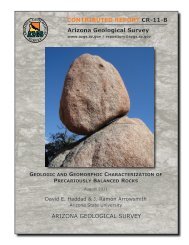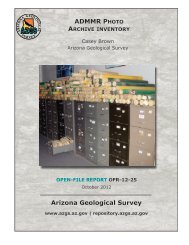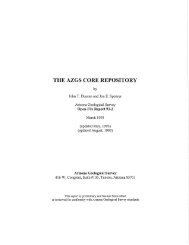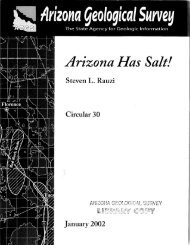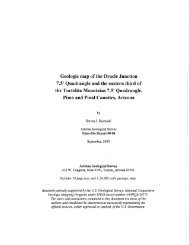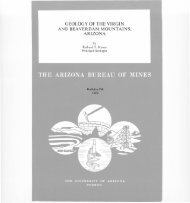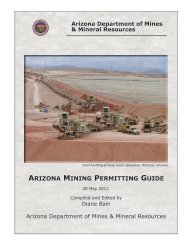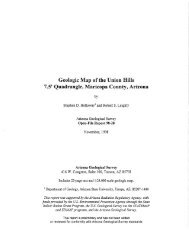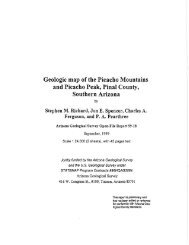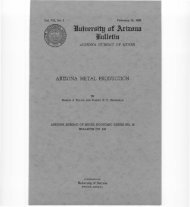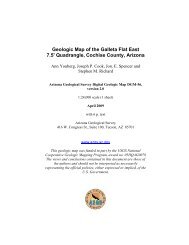Subsurface Geologic Investigation of Fountain Hills - AZGS ...
Subsurface Geologic Investigation of Fountain Hills - AZGS ...
Subsurface Geologic Investigation of Fountain Hills - AZGS ...
You also want an ePaper? Increase the reach of your titles
YUMPU automatically turns print PDFs into web optimized ePapers that Google loves.
into the basin. Water flows downward through the unsaturated zone in a broad band<br />
paralleling the mountain front. The width <strong>of</strong> the recharge zone is dependent on the nature<br />
and magnitude <strong>of</strong> the run<strong>of</strong>f from the consolidated rock areas. This recharge occurs near<br />
the mountain fronts at the intersection <strong>of</strong> the bedrock outcrop and alluvial surface. Two<br />
areas in the sub-basin where significant recharge is likely to occur are along Camp Creek<br />
in the north and Sycamore Creek in the eastern portion <strong>of</strong>the sub-basin.<br />
The younger basin-fill deposits to the northwest along Camp Creek are grussy and<br />
for the most part only moderately consolidated. These deposits are deeply dissected along<br />
Camp Creek, which is a major tributary to the Verde River in the basin. Camp Creek is<br />
very wide and floored by unconsolidated sand and gravel, and the majority <strong>of</strong> flow in<br />
Camp Creek is subsurface flow. It is not known what rocks lay beneath the younger<br />
basin-fill deposits in this area, or how permeable they are.<br />
On the east side <strong>of</strong> the valley, Sycamore Creek drains a large area <strong>of</strong> the west<br />
central Mazatzal Mountains. The creek travels through a narrow gorge across bedrock<br />
until it enters younger basin-fill sediments just north <strong>of</strong> Adams Mesa. Here it fans out<br />
into a wide flood plain floored by unconsolidated sand and gravel. Well data show that<br />
unconsolidated deposits exist to a depth <strong>of</strong> at least 105 feet (Thomsen and Schumann,<br />
1968). Thomsen and Schumann (1968) found that the coefficient <strong>of</strong> permeability for<br />
unconsolidated alluvium in the wash and the basin-fill deposits were very different. They<br />
calculated the hydraulic conductivity <strong>of</strong> the unconsolidated alluvium as 5,200 gpdlft2,<br />
while the hydraulic conductivity <strong>of</strong> the basin-fill deposits was only 8.3 gpd/fe. They<br />
calculated that the velocity <strong>of</strong> water in both deposits was 18.5 ftlday (6,750 ftlyr) and<br />
0.04 ftlday (15 ftlyr), respectively. Because the unconsolidated alluvium is so permeable,<br />
less than 10% <strong>of</strong> the average run<strong>of</strong>f from the upper bedrock area <strong>of</strong> Sycamore Creek<br />
reaches the Verde River as streamflow (Thomsen and Schumann, 1968). Most <strong>of</strong> the<br />
water slowly flows to the Verde River through the subsurface unconsolidated alluvium.<br />
Very little water percolates into the underlying basin-fill deposits. From direct<br />
observation, most <strong>of</strong> the basin-fill deposits (map unit Tsy) in the valley are similarly<br />
well-cemented and probably have moderate to low permeability, especially compared to<br />
the unconsolidated alluvium.<br />
18



